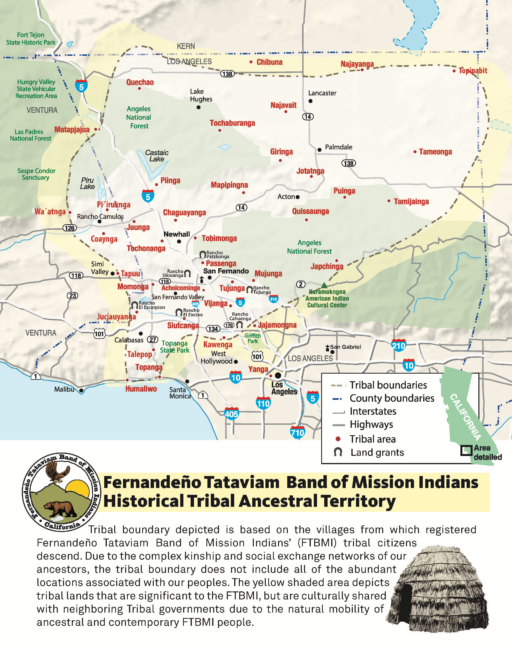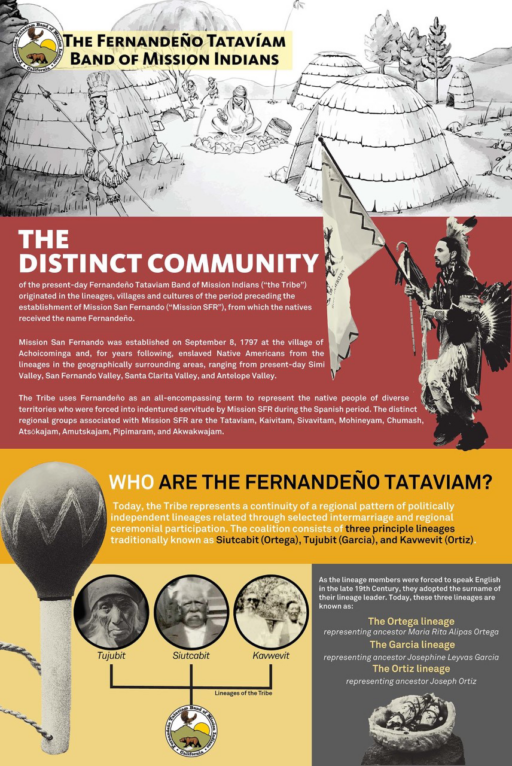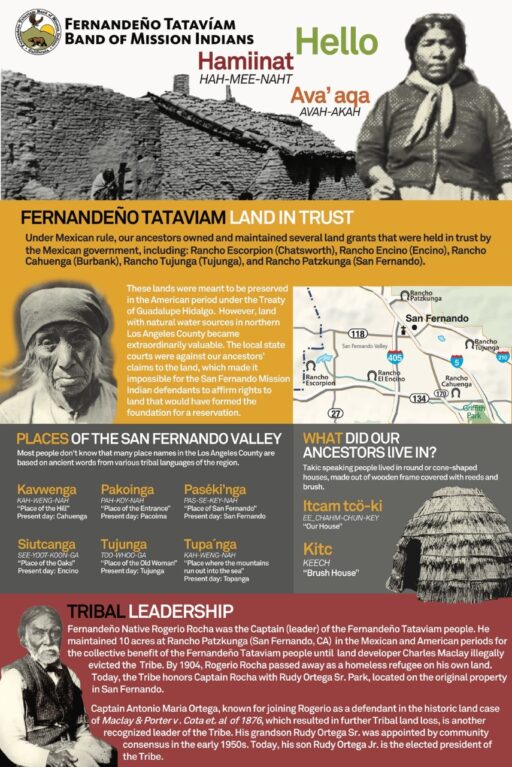Fernandeño Tataviam Band of Mission Indians
Sovereign Indian Nation of Northern Los Angeles County
Tribal Administration Office
1019 2nd Street
San Fernando, CA 91340
Tele: 818-837-0794
Fax: 818-837-0796
Administration@tataviam-nsn.us
www.tataviam-nsn.us
Hamiinat (HAH-MEE-NAHT)! Ava’aqa (AVAH-AKAH)! Hello!
The distinct community of the present-day Fernandeño Tataviam Band of Mission Indians (“the Tribe”) originated in the lineages, villages and cultures of the period preceding the establishment of Mission San Fernando (“Mission SFR”), from which the natives received the name Fernandeño. Mission SFR was established on September 8, 1797 at the village of Achoicominga and, for years following, enslaved Native Americans from the lineages in the geographically surrounding areas, ranging from present-day Simi Valley, San Fernando Valley, Santa Clarita Valley, and Antelope Valley. Today, the Tribe consists of a voluntary coalition of those lineages and the historical Fernandeño Indian Tribe bound together by a Tribal constitution. The Tribe is headquartered in San Fernando, California across from City of San Fernando’s City Hall, and serves over 900 citizens – the majority of whom live within our traditional homelands of northern Los Angeles County.
Traditionally, there was no collective tribal entity above the lineage. Before the founding of Mission SFR, each lineage was autonomous and self-governing, living within villages that were associated with regional areas, or territories, defined culturally by a regional group. Each lineage held territory and maintained political and economic sovereignty over its local area, but was also linked through social exchange to neighboring villages and lineages. The Fernandeños exercised power over territory, self-government, a judicial system, and upheld a network of social, economic, and political ties to other lineages over an extensive area. The lineage system continued as the major form of social and political organization through the Spanish period, and is the primary form of indigenous organization among the present-day Fernandeños.
Under Mexican rule, the Tribe’s ancestors owned and maintained several land grants that were held in trust by the Mexican government, including Rancho Escorpion (Chatsworth), Rancho Encino (Encino), Rancho Cahuenga (Burbank), Rancho Tujunga (Tujunga), which were meant to be preserved in the American period. However, land in northern Los Angeles County, particularly areas with natural water sources, became extraordinarily valuable, and the local state courts were against our ancestors’ claims to the land, which made it impossible for the San Fernando Mission Indian defendants to affirm rights to land that would have formed the foundation for a reservation.
Today, the Tribe represents the continuity of the regional pattern of politically independent lineages related through selected intermarriage and regional ceremonial participation. This coalition consists of three principle lineages traditionally known as Siutcabit, Tujubit, and Kavwevit. As the lineage members were forced to speak English in the late 19th Century, they adopted the surname of their lineage leader. Today, these three lineages are known as the Ortega lineage (representing ancestor Maria Rita Alipas Ortega), the Garcia lineage (representing ancestor Josephine Leyvas Garcia), and the Ortiz lineage (representing ancestor Joseph Ortiz).
Tribal Jurisdiction

Free Educational Materials For Download



